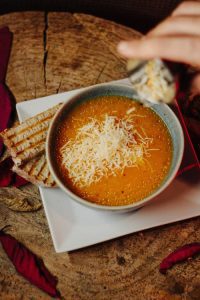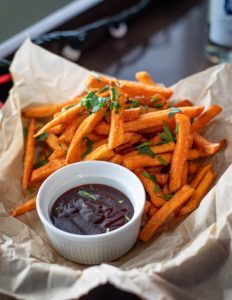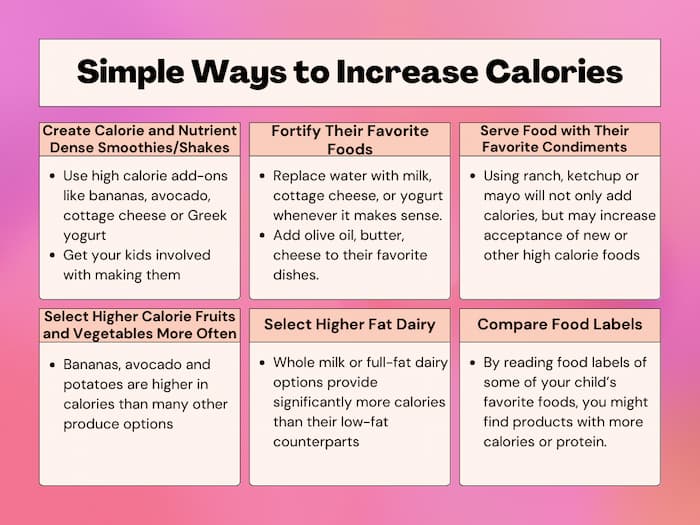Navigating meals with picky eaters can pose quite a challenge. If you find yourself wondering if your child is eating enough or getting adequate calories, you’re not alone. In this post, we will go over 16 high calorie foods for kids and 5 simple ways to increase calories.

As someone with two picky toddlers, I understand just how frustrating it can be – especially when it feels like you did “all the things” to expose them to a variety of foods when they were babies. Not all of these foods will be accepted, and some of these strategies might not work – but hopefully this post brings some success and relieves some of those worries you might have.
These ideas could work for pregnant women who are struggling to eat enough, as well! Or anyone looking to increase caloric intake in a healthy way.
Food Neophobia and Picky Eating
Between the ages of 2-6, there is an increase in a child’s independence and autonomy which can lead to food neophobia. Food neophobia is defined as the refusal of new or unfamiliar foods. It is considered a natural stage of development that gets better with age, and only a concern if it worsens.
Although this phase is considered “normal”, it’s important to continue to offer new foods to combat picky eating. It may take up to 10-15 times for a child to accept them. Don’t give up on a new food!
However, a 2020 study examined picky eaters in the U.S. found that picky eating can start early and stay that way. Temperament also plays a role – they found that children who had difficulty controlling their emotions were often picky eaters.
“Picky eating” can be totally normal, but it’s important to continue to instill healthy eating practices – with hopes this “phase” will improve by the age of 6. Practice and exposure is key!
When to Seek Professional Help
Often we worry that our child is underweight due to their selective eating habits. However, studies have found that while picky eaters are often thinner than their peers – it’s usually not in an unhealthy way. Unless your pediatrician is worried about their weight, then you shouldn’t be either.
If your child is over the age of 4, and their picky eating is starting to affect their mood, growth, and weight in a significant way – it might be time to seek help. Experts recommend seeing a speech therapist who specializes in feeding issues as well as a pediatric dietitian with experience in picky eating.
High Calorie Foods for Kids
These foods can be offered on their own, or incorporated into one of the ideas listed below – depending on your child’s food preferences. As someone with TWO picky eaters, I know that you might try to offer some of these foods and face rejection.
When it comes to actual acceptance, ask yourself – what do I know my toddler will eat? From there, use this list of high calorie foods and ideas to think of where you can add in additional calories. This might increase the chance that they will actually eat it.
Healthy Fats
1. Avocado
Avocadoes are both calorically dense and nutrient dense– meaning they provide a lot of calories and nutrients in just a small serving size. One medium-sized avocado provides 240 calories, 22 grams of healthy fat, 10 grams of fiber, as well as high amounts of vitamin C and potassium.
If your child is not a fan of eating avocado or guacamole by itself, here are some ideas for incorporating them into meals:
– Spread on a slice of bread and make a sandwich or grilled cheese.
– Add frozen avocado to smoothies, or homemade popsicles.
– Make cheese quesadillas with avocado spread thinly across a tortilla.
– Blend with cream cheese or sour cream for a dip with chips.

2. Nut Butters
Nut butters are high in both calories and protein. If your child is a fan, just giving them a spoonful of peanut butter mixed with yogurt can help increase calories. One tablespoon of peanut butter is 90 calories and 4g protein.
Other ideas for incorporating them are:
– Peanut butter sandwiches.
– Top oatmeal with 2 Tbsp. of nut butter.
– Add to smoothies or shakes.
– Mix with yogurt and sliced bananas.
3. Olive Oil
Olive oil contains 120 calories in just one tablespoon. Think of ways you can use olive oil for additional calories on your child’s favorite foods.
These ideas can be substituted with butter as well.
– Add a tablespoon to their macaroni and cheese.
– Spread on the outside of each slice of bread when making grilled sandwiches.
– Sauté veggies or meats in olive oil.
– Add to rice, pasta or cream sauces.
4. Cheese
Cheese is a great source of calcium, and usually a favorite among even the pickiest kids. Cheese can be tossed into soups, or melted over pasta or vegetables.

5. Nuts
Finely sliced or chopped nuts are easy high calorie toppings on oatmeal, yogurt, puddings, or even in their pasta or mac and cheese. Just a small portion of nuts is higher in calories because it is a healthy fat.
Milk and Milk Products
6. High Calorie Nutrition Drinks
One packet of Carnation Instant Breakfast mixed with whole milk provides 250 calories and 14 grams of protein. This powder can also be mixed into yogurt, shakes, or smoothies.
Boost Kids Essentials is another option, providing 240 calories and 7 grams of protein.
7. Cottage Cheese and Greek Yogurt
Both subtle in flavor, cottage cheese and Greek yogurt are great high-protein substitutes for cream or milk in a variety of dishes. One 1/2 cup serving contains about 14 grams of protein! Select higher fat options for more calories.

Ideas to try:
– Cottage cheese macaroni and cheese
– Cottage cheese pasta sauce
– Add yogurt or cottage cheese to smoothies
– Cottage cheese ice cream
– Mix with maple syrup and add as a topping on pancakes or waffles
8. Milk
If you have a toddler who loves milk, but is struggling to gain weight – consider adding 4 oz. of half-and-half to 4 ounces of whole milk. Another option: add one or two tablespoons of non-fat dry milk to cereal, soups, milkshakes, pancakes or macaroni and cheese to “sneak” in some additional calories.
Meat and Proteins
9. Shredded or Finely Diced Meat
Often, the texture of meat can be very off-putting for toddlers. Cutting meat up into very small pieces and incorporating into his or her favorite dishes might help.
Higher fat cuts of meat, like chicken thighs or steak, can provide more calories in a smaller serving.
10. Nutritional Yeast
Nutritional yeast is a vegan, gluten-free seasoning that contains 40 calories and 5 grams of protein per two tablespoon serving. It has a nutty, cheese-like flavor. Add it to pasta, soup, casseroles, dips, and cheese sauces!
11. Protein Powders
If you have a child who is struggling to gain weight or eat foods with protein, protein powder can be appropriate and safe. Check out this article which compares some of the best options for children, approved by a pediatric nutritionist. Smoothies are a fun way to get your child involved in the kitchen – which might just help their acceptance of it.
12. Beans
A 1/2 cup serving of beans is 120 calories and 8 grams of protein! That is – if your child will eat them!
Ideas to incorporate beans:
– Add them to a soup which might increase acceptance
– Some people put beans in their smoothies as they are very mild in flavor – like this kid-friendly chocolate smoothie
– Bean tacos or quesadillas
Grains and Starches
13. High Protein Pasta
Pasta itself is higher in calories, but a good trick I’ve found that works well is selecting noodles with a little more protein. There are many variations on the market these days – like the popular Banza noodles.
My favorite for picky toddlers is Barilla Protein +, providing 10 grams of protein per serving!
14. Rice
Grains like rice provide about 200 calories in a 1 cup serving. Add butter, olive oil, or cheese to increase calories and acceptance.
15. Potatoes/Sweet Potatoes
Potatoes are nutrient and calorie dense and can be prepared in many ways. They get a bad reputation but both traditional potatoes and sweet potatoes are excellent sources of many nutrients and very kid friendly.

– Cut them into fries which most picky toddler would love (with a side of ranch or ketchup, most likely).
– Serve them mashed with butter, oil, cheese, Greek yogurt, or any other toppings they would like.
– Make a sweet potato mash with maple syrup and brown sugar.
16. Bananas
Bananas are one of the more calorically dense fruits, with one medium banana providing about 110 calories. They’re great to add to smoothies, oatmeal, pancakes, ice cream, and yogurt. They also make a great snack!
5 Simple Ways to Increase Calories
6 simple ways to increase calories of your child’s food. Of course, it is still very important to expose your child to new foods – but sometimes the best way to ensure your picky child is eating enough is to sneak it in.
1. Create calorie and nutrient dense smoothies and shakes. Get them involved with this, as cooking with children has been shown to improve meal acceptance and prevent picky eating! Turn meals into fun, engaging experiences.

2. Fortify their favorite foods whenever you can.
– Replace water with milk, whipped cottage cheese, or yogurt whenever it makes sense.
– Add olive oil, butter or cheese to pastas, soups, mac and cheese, etc…
– Sneak in avocado if they enjoy sandwiches, quesadillas, or dips. Serve it on their favorite crackers or chips.
3. Serve their foods with their favorite condiments. Ranch and mayonnaise are particularly high in calories as well.
4. Select higher calorie vegetables or fruits more often, like bananas and potatoes.
5. Choose higher fat dairy products for more calories. Whole milk, full fat yogurt, and cottage cheese have significantly more calories than their low-fat counterparts.
6. Compare food labels of some of your child’s favorite staples – you might find a similar product that is higher in calories or protein (like the Barilla Protein+ pasta).

Key Takeaways on High Calorie Foods for Kids
There’s a lot to worry about as a mom, and picky eating can create a headache of worries. It’s important to remember that us parents are not at fault. Food neophobia is normal, and with repeated exposure and practice it will likely get better.
Until then, offering high calorie foods and using strategies to increase calories of their preferences can help to relieve some of the worries and promote healthy growth.
If you feel like your child’s picky eating habits are severe, there’s no harm in seeking professional help!

